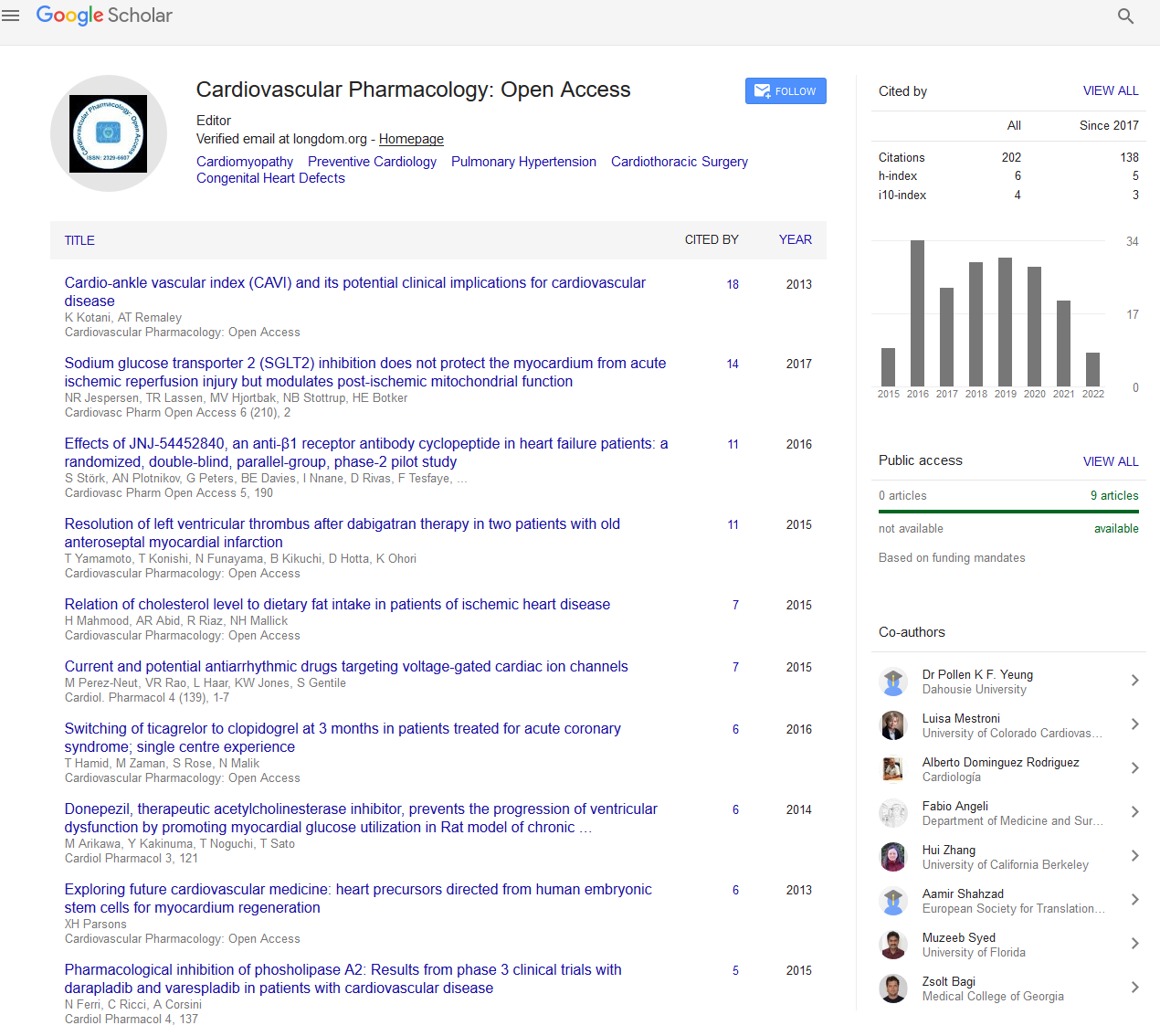Indexed In
- Open J Gate
- Cosmos IF
- RefSeek
- Hamdard University
- EBSCO A-Z
- OCLC- WorldCat
- Publons
- Geneva Foundation for Medical Education and Research
- Euro Pub
- Google Scholar
Useful Links
Share This Page
Journal Flyer

Open Access Journals
- Agri and Aquaculture
- Biochemistry
- Bioinformatics & Systems Biology
- Business & Management
- Chemistry
- Clinical Sciences
- Engineering
- Food & Nutrition
- General Science
- Genetics & Molecular Biology
- Immunology & Microbiology
- Medical Sciences
- Neuroscience & Psychology
- Nursing & Health Care
- Pharmaceutical Sciences
Brief Commentary - (2023) Volume 12, Issue 2
RAAS Inhibitors for the Treatment of Rheumatic Heart Disease
Jouven Xavier*Received: 03-Mar-2023, Manuscript No. CPO-23-20552; Editor assigned: 06-Mar-2023, Pre QC No. CPO-23-20552 (PQ); Reviewed: 20-Mar-2023, QC No. CPO-23-20552; Revised: 27-Mar-2023, Manuscript No. CPO-23-20552 (R); Published: 03-Apr-2023, DOI: 10.35248/2329-6607.23.12.341
Description
The majority of developed regions have almost Rheumatic Heart Disease (RHD), however both underdeveloped countries and the undeveloped regions still have a high morbidity and mortality rate. Based on expanding data on subclinical RHD, new incidents likely reflect the total worldwide prevalence of the disease, and RHD continues to be a significant global health issue. The primary strategies for lowering RHD mortality continue to be the surgical and medical management of RHD complications. The primary therapy for RHD is surgical intervention to alleviate valvular damage, mostly through percutaneous balloon valvuloplasty, atrial commissurotomy, valve repair, and/or valve replacement. Since it showed signs of the timing effect. Surgical methods improve the short- and long-term prognosis of RHD patients. The benefits of long-term prognosis are lower, and the mortality and valve-related complications such as Heart Failure (HF) rehospitalisation, Atrial Fibrillation (AF), and thrombo-embolism are higher, compared to the improvement of short-term prognosis on RHD patients. Despite this, it is generally not available to most RHD patients in the true clinical practice in poor countries due to social, educational, and economic limitations, especially for those patients with advanced stage or significant surgical risk due to combination with other disease. To improve the prognosis for RHD patients under these conditions, it is vital to investigate alternative medication and surgical treatment plans.
Myocardial injury and left ventricular dysfunction caused by rheumatic heart disease are connected with mechanical damage to the valve rather than direct involvement of the myocardium. Hence, it cannot be adequately treated or removed without surgery. Standard antibiotics and surgical intervention, however, completely eradicate the clinical signs of rheumatic activity and subclinical persistent myocarditis, but the chronic non-specific inflammation in the myocardial, atrial, and valvular tissues endures. Such damage eventually leads to poor surgical tolerance and a poor long-term prognosis by causing the progressive development of myocardial, atrial, and valvular disorders. An essential part of this process is the local Renin-Angiotensin- Aldosterone System's (RAAS) activation. During cardiac surgery, the expression of the angiotensin II receptor type 1 was clearly enhanced in RHD patients with AF. As RAAS antagonists such as Angiotensin-Converting Enzyme Inhibitors (ACEIs) or Angiotensin Receptor Blockers (ARBs), renin-Angiotensin- Aldosterone System inhibitors (RAASi) not only reverse cardiac remodeling but also have anti-inflammatory effects, which could theoretically improve the prognosis of RHD patients.
The most recent clinical guidelines only advise RAASi for HF patients with valvular heart disease who are deemed inappropriate for surgical therapy and patients who continue to experience HF symptoms after valve surgery; nevertheless, the function of RAASi in the treatment of RHD patients is still not clearly revealed. Previously, a few studies enrolled limited numbers of idealised RHD patients with any single valve-single lesion and reported subjective or surrogate outcomes. These trials were created or powered with the intention of evaluating the hard outcomes associated with the use of RAASi in RHD patients with significant and complex valve damage.
In the current retrospective real-world investigation, we sought to determine the relationship between RAASi and long-term results in RHD patients, particularly when used in conjunction with surgical therapy. When compared to the control group, the allcause death and CVD were decreased by 48% and 52%, respectively, in the RAASi group. Additional subgroup study revealed that RHD patients who did not undergo surgery still benefited from RAASi therapy, with a matching 50% and 52% reduction.
RAASi treatment was significantly related with a decreased risk of death for patients who had undergone percutaneous mitral valve repair, aortic valve replacement, or simultaneous aortic and mitral valve replacement after receiving the treatment. Rheumatic heart disease is uncommon, as are rheumatic aortic or tricuspid valve illnesses. There is no discernible distinction between rheumatic and degenerative aortic valve dysfunction from the standpoint of inflammation. RAASi were linked to considerably lower all-cause mortality in patients with aortic regurgitation. RAASi may increase survival in patients with degenerative aortic valve disease in addition to that, according to a recent study. Patients with rheumatic heart disease receiving RAASi treatment experienced improved long-term clinical outcomes and decreased incidences of cardiovascular events, particularly when combined with surgical treatment. This can be a useful addition to current surgical-based treatment options and serves as a measure for the prevention and treatment of RHD in developing countries and regions.
Citation: Xavier J (2023) RAAS Inhibitors for the Treatment of Rheumatic Heart Disease. Cardiovasc Pharm. 12:341.
Copyright: © 2023 Xavier J. This is an open access article distributed under the terms of the Creative Commons Attribution License, which permits unrestricted use, distribution, and reproduction in any medium, provided the original author and source are credited.


